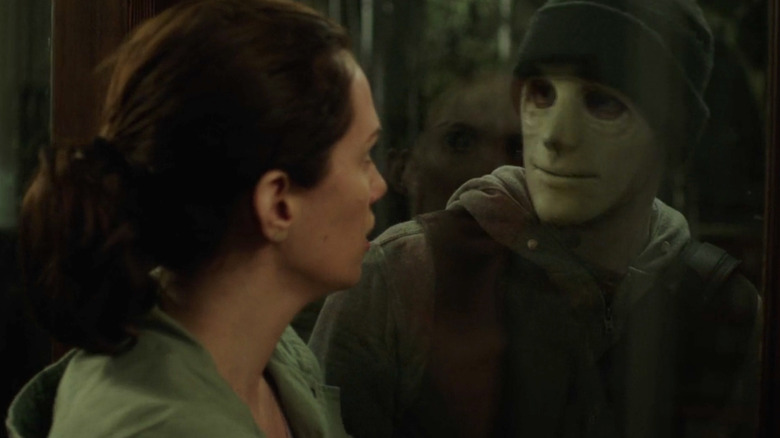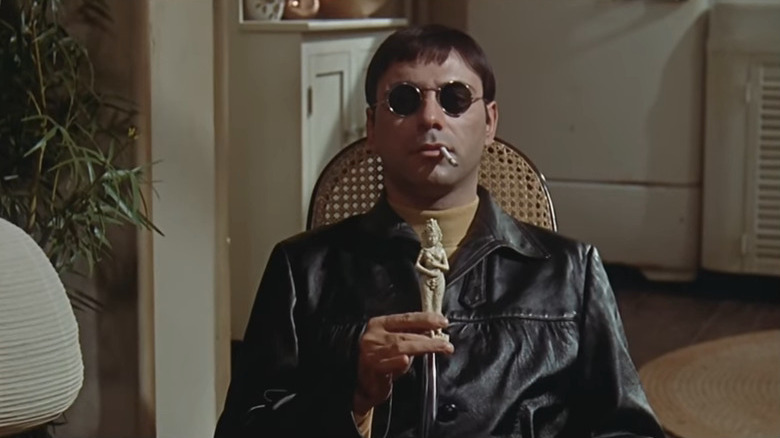The Horror Influences That Inspired Mike Flanagan's Hush
Sensory horror has had a steady place in the spotlight for the past few years; drop one of the five senses and the storytelling can go to some interesting places. "Bird Box" punishes its victims in that most Eldritch of ways, for looking: Witnessing its unseen creatures drives the beholder to suicidal madness. The apocalyptic beasts of "A Quiet Place" can't see you, but they'll bring a world of hurt if they hear you. Unfortunately for the bad guy of Mike Flanagan's "Hush," deaf-mute horror author Maddie Young (played by co-writer Kate Siegel) proves to be no easy target.
The 2016 horror movie continues to steadily make appearances on Netflix's trending section, forever finding audiences to thrill with Maddie's writing retreat from hell. Lacking vocal cord function and experiencing permanent hearing loss after a childhood illness, Maddie can't scream when The Man (John Gallagher Jr. of "10 Cloverfield Lane"), an armed, masked intruder, terrorizes her. Flanagan spoke to Bloody-Disgusting about the origins and cinematic ancestors of "Hush":
"Well, we talked a lot but it kind of happened because Kate [Siegel] and I were out to dinner and we were talking about movies we liked. One of the ones that we stumbled on that we both really liked was 'Wait Until Dark.' So we talked about that for a little bit and then talked about thrillers in general and the things that she had always wanted to do from an acting point of view and things that I had always wanted to do from a directing point of view."
The storytelling duo further pulled from low-dialogue TV offerings like the "Hush" episode of "Buffy the Vampire Slayer" and the "Battleground" adaptation pilot of Stephen King's "Nightmares & Dreamscapes," where sound is everything.
'We could do things that we couldn't do if your character could speak or hear'
Flanagan further explains that "Hush" gave ample opportunity for the "Midnight Mass" director to wade into new creative waters, coupling a minimal-dialogue narrative with "the anxiety of seeing somebody try to get into your house." Making the lead character deaf-mute provided a chance to do something special with the home invasion subgenre.
And something special they did. "Hush" is a sensory gem not only alongside its 1966 kin, but right at home with contemporary noise-disciplinary horror like "Don't Breathe" where sensory advantages quickly become disadvantages all around (superior hearing, for example, finds little leverage when the smoke alarm goes off). But like the protagonists of its predecessors, the star of "Hush" finds ways to even the playing field, and there, Siegel sees the sound design as the movie's most tension-raising element. She tells Bloody-Disgusting:
"Sound design really sells a movie, so we were discussing ways to make sound design more of a character on a script level. To really make sure that sound design is something that gets the weight it deserves. The opposite of that is to remove sound from the main character, since you have to balance that somewhere else in the movie. I think that at the beginning Maddie being a deaf-mute was something that was more of a script challenge. Then as we started to meet this woman, we realized that it was a real benefit to character development, tension and things like that. We could do things that we couldn't do if your character could speak or hear."
Not a bad predecessor
In terms of inspiration, "Wait Until Dark" sets a high bar. The story boasts a stacked cast (Audrey Hepburn! Alan Arkin! Richard Crenna! Jack Weston!) and precisely the kind of tale that Flanagan revels in weaving: A melodrama that happens to get eerie at just the right moments.
The home invasion thriller stars Hepburn as Suzy, a young blind housewife at the mercy of drug-seeking criminals, led by Alan Arkin's Roat –- one of the greatest movie villains of all time. Armed with a switchblade, cunning, and a fake mustache so unbelievable he's lucky Suzy couldn't see it, Roat is on the hunt for an illicit payload concealed, unbeknownst to Suzy, inside an old-timey doll hidden somewhere in her home. It was a commercial and critical success, with Time Magazine giving higher praise for the feature than the Frederick Knott play it was based on. For those wondering if the movie has the scary goods, there is a jump scare that made the forever-hallowed list of Bravo's 100 Scariest Movie Moments at number ten, just ahead of Takashi Miike's J-horror nightmare "Audition." For his part, Flanagan looked at the Audrey Hepburn vehicle and others like it, and saw the potential for a challenging project. He told Fangoria:
"What I love about that is that it forces you to create a hypnotic experience for the viewer, so for years, I've wanted to see what would happen if I removed dialogue from the equation. It's something we lean on so much as filmmakers; we're in a visual medium, but we tell most of our stories verbally. I thought it would be an awesome challenge to remove that."
"Hush" is currently streaming on Netflix to launch for your movie night needs, and remember the rule: low lights, high sound!


